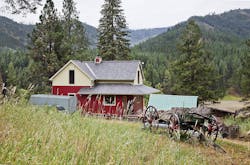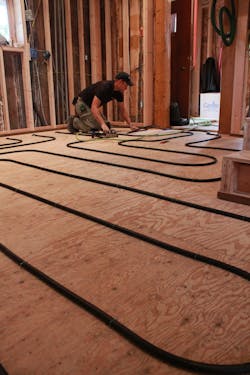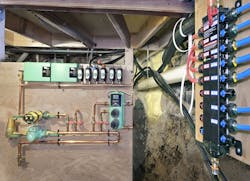When in Missoula, do as Missoulians do, which would probably include hiking, biking, fishing, skiing, kayaking on the Clark Fork and Bitterroot Rivers, talking about the different forest fires currently burning in the area, and generally soaking up every ounce of the outdoors as possible.
But to really, truly be accepted by the vista-loving locals, you’d need to adopt some colloquialisms, such as pronouncing “creek” like “crick, or referring to anything with three or more wheels and an internal combustion engine as a “rig.”
Locals — thanks to home-grown trade pros like Andy Mickelson, owner of Missoula-based Mickelson Plumbing and Heating Inc. — have also learned the advantages of matching a modulating boiler with radiant heat or snowmelt systems; a fine match for mountain homes.
Mickelson, a self-proclaimed hydronics junky and Montana native, cut his teeth on boiler systems — big ones — while working for one of the larger mechanical outfits on the western side of the state. After 13 years, he decided it was time to start his own company. In 2011, he bought a new rig and tools and hasn’t looked back since.
Commercial workout
“I’m fortunate to have received the training I did,” said Mickelson. “A few years into the trade, I literally became the arms and legs of a seasoned pipefitter while he recovered from hip replacement surgery. He was one of the remaining few in the area who could service some of the massive heating systems, often steam, and continued working despite his loss of mobility. I’d climb the ladder and haul the tools. He’d tell me what to do.”
The experience made Mickelson a man in demand. In rural parts of Montana, which account for 99% of the state’s land mass, wood and coal-fired steam is still prevalent in buildings like schools and hospitals. More than a few facility managers have Mickelson on speed dial. He makes the drive (up to150 miles each way) and they pay him well for his know-how.
Mickelson’s skill set also includes commercial controls, plumbing and air conditioning, but the bulk of his work consists of custom hydronic systems in new and existing homes. From mild to wild, his craftwork appears in residences under 1,000-sq.ft., and homes that can almost be measured by the acre.
Lewis and Clark
The great American adventurers passed through the Missoula Valley in the early 1800s. Some accounts note the posse marching directly through a current Mickelson jobsite. Miller Creek, as the little valley is called, lies a few miles outside of Missoula. Aside from one lonely power line, time has forgotten the beautiful valley, at least until Mickelson showed up.
Just off the dirt road, a modest cabin commands views of the valley. At first, it looks like a small, very well-constructed new home. But the aged outbuildings nearby, with their weathered wood siding, tell a different story. The now immaculately restored cabin, at roughly 1,100-sq.ft., is rumored to have been a cavalry stockade in the 1800s.
While the outside of the home conceals the structure’s age, inside, the hand-hewn vertical logs remain exposed. Before new chinking was added, the gaps between the 8-in. thick logs showed four inches of spray foam insulation that the owners used to bring the building into the 21st century, thermally speaking.
But insulation and a tight envelope aren’t the only changes taking the stockade from drafty to cozy. Mickelson is using a thin-slab radiant system, along with vertical and horizontal Runtal radiators to efficiently heat the outpost. In the hand-dug dirt basement, improvements continue.
“Everything in the house is small,” said Mickelson. “The building itself, the heat load and the zones. So what we really needed to perfect comfort and efficiency was a flexible system. A small modulating boiler and variable speed, delta-T pumping were a must.”
Just right
“It’s not unheard-of for temps to dip into the -30s at night here,” said Michael Wegener, who owns the stockade and nearly 1,300 acres that it sits on. “When we decided to turn the building into a home, my wife and I wanted it to be as efficient and comfortable as possible without losing the charm of the exposed logs inside.”
With a -10°F outdoor design temp, the total heat load came in at just under 30,000 BTUs. Mickelson installed a Lochinvar boiler with a 50-gal. sidearm tank. A woodstove in the center of the home provides ambiance or extra heat on the coldest nights. The area’s ground water drops to the low 40s in the winter, so Mickelson knew he’d need a decent sized tank despite the home’s size.
Closely spaced Ts allow the boiler loop’s 007 circulator to move water to other pumps in the system, which include a variable-speed Taco Bumble Bee for the radiators, and a Taco Radiant Mixing Block for the thin-slab radiant. Thesix zones are each activated by a ball-valve style Zone Sentry valve, and a 4900 air separator eliminates any entrained air. Both the boiler and the mixing block use an outdoor reset sensor for perfect supply temps.
“Since this is an old existing structure, and built like a fortress, running pipe proved to be difficult,” he continued. “It would have been nearly impossible with any PEX product, so I went with half-inch Watts Radiant Onix pipe. You can tie the stuff in knots and it won’t kink, even with its aluminum oxygen barrier.”
Bundles of the black pipe can be seen suspended from the basement ceiling, heading off to the in-floor zones of the kitchen and laundry/mud room area. The Onix was also used as the supply tubing for the radiators. To rapidly bring the bathroom floor surface up to a comfortable temperature, Mickelson used Watts HeatWeave electric mat.
“Having six micro-zones in this house plus an indirect tank for DHW made circulation a bit challenging,” explained Mickelson. “The key was using a variable-speed, delta-T configuration. All of Taco’s products, from the air separator to the radiant mixing block, work together seamlessly to provide exactly what this home needs.”
Trainer and paterfamilias
“Since Sheryl and I have been married, we’ve lived in four different houses,” said Mickelson. “Having an uncomfortable heating system during a Montana winter — especially with young kids — just isn’t any fun. I think that’s one of many reasons I’m so adamant about providing homeowners with exactly what they want, and exceeding their expectations.”
“I’ve far surpassed where I thought I’d be with the business at this point,” he continued. “Without question, scheduling is my biggest challenge. I simply can’t be in two places at once if a job drags out, like you can when you have several employees.”
“It’s been a great ride,” he continued. “Aside from hard work and diligence, I’d have to attribute the success to my wife, my local contacts, and the training I’ve received. So I do my best to help provide others with the same training opportunities.”
Mickelson is a trainer with UA Plumbers and Pipefitters, Local 459. He typically teaches one class each year. Topics range from hydronic heating and cooling to electric controls and backflow prevention.
“One thing I try to instill in the apprentices, is that there’s definitely opportunity in this trade,” said Mickelson. “If they’re willing to put forth the effort and learn to do the job right, they’ll stay busy … even in rural Montana.”






